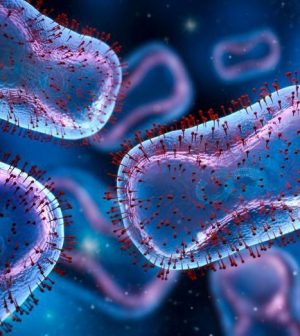- Navigating Your Midlife Crisis: Embracing New Possibilities
- City Raccoons Showing Signs of Domestication
- Mapping the Exposome: Science Broadens Focus to Environmental Disease Triggers
- One Week Less on Social Media Linked to Better Mental Health
- Your Brain Changes in Stages as You Age, Study Finds
- Some Suicide Victims Show No Typical Warning Signs, Study Finds
- ByHeart Formula Faces Lawsuits After Babies Sickened With Botulism
- Switch to Vegan Diet Could Cut Your Greenhouse Gas Emissions in Half
- Regular Bedtime Does Wonders for Blood Pressure
- Dining Alone Could Mean Worse Nutrition for Seniors
Mpox Virus Can Replicate on Surfaces for Days: Study

Most cases of mpox are spread from skin-to-skin contact, but it is possible to catch the virus by touching a contaminated surface in a house or a hospital room, according to a new study.
Researchers studying this found temperature made a difference. The virus could survive at room temperature on a surface for up to 11 days. At 4 degrees Celsius (39 degrees Fahrenheit), it could survive for up to a month.
“Smallpox viruses are notorious for their ability to remain infectious in the environment for a very long time,” explained study author Toni Meister, from the molecular and medical virology department at Ruhr University Bochum in Germany. “For monkeypox [now called mpox], however, we didn’t know the exact time frames until now.
“Our results support the WHO’s recommendation to use alcohol-based surface disinfectants,” Meister said in a university news release.
The study team applied the virus to sanitized stainless steel plates, storing them at different temperatures: at 4 degrees C, 22 degrees C (about 72 degrees F) and 37 degrees C (about 99 degrees F).
Researchers found little change in the amount of infectious virus during the first few days at any temperature.
It took five days for the virus concentration to drop significantly at 22 and 37 degrees C.
After six to seven days at 37 degrees, no virus capable of reproducing was detected.
It took about 10 or 11 days for no infection to be possible at 22 degrees.
At 4 degrees C, it took 30 days until the virus was no longer infectious. It didn’t drop sharply until 20 days had passed.
“This is consistent with our experience that people can still contract monkeypox from surfaces in the household after almost two weeks,” said Eike Steinmann, head of the molecular and medical virology department at Ruhr.
This means it’s important to disinfect surfaces. Alcohol-based surfaces were very effective on mpox, while hydrogen peroxide-based disinfectants did not do the job, the researchers noted.
The study findings were published recently in the Journal of Infectious Diseases.
More information
The U.S. Centers for Disease Control and Prevention has more on mpox.
SOURCE: Ruhr University Bochum, news release, May 16, 2023
Source: HealthDay
Copyright © 2025 HealthDay. All rights reserved.










